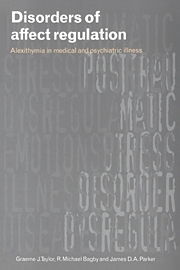Book contents
- Frontmatter
- Contents
- Foreword
- Acknowledgments
- Acknowledgment of permission for use of material
- Introduction
- 1 The development and regulation of affects
- 2 Affect dysregulation and alexithymia
- 3 Measurement and validation of the alexithymia construct
- 4 Relations between alexithymia, personality, and affects
- 5 The neurobiology of emotion, affect regulation, and alexithymia
- 6 Somatoform disorders
- 7 Anxiety and depressive disorders and a note on personality disorders
- 8 Substance use disorders
- 9 Eating disorders
- 10 Affects and alexithymia in medical illness and disease
- 11 Treatment considerations
- 12 Future directions
- Appendix
- References
- Index
2 - Affect dysregulation and alexithymia
Published online by Cambridge University Press: 21 September 2009
- Frontmatter
- Contents
- Foreword
- Acknowledgments
- Acknowledgment of permission for use of material
- Introduction
- 1 The development and regulation of affects
- 2 Affect dysregulation and alexithymia
- 3 Measurement and validation of the alexithymia construct
- 4 Relations between alexithymia, personality, and affects
- 5 The neurobiology of emotion, affect regulation, and alexithymia
- 6 Somatoform disorders
- 7 Anxiety and depressive disorders and a note on personality disorders
- 8 Substance use disorders
- 9 Eating disorders
- 10 Affects and alexithymia in medical illness and disease
- 11 Treatment considerations
- 12 Future directions
- Appendix
- References
- Index
Summary
Because the capacities for experiencing and regulating affects cognitively are acquired during the developmental years, opportunities easily arise for failure (Dodge & Garber, 1991; Taylor, 1992b). Such failures result in a proneness to affect dysregulation that is evident in personality traits or psychopathology and poor physical health. The major psychopathologies and physical pathologies are conceptualized in this book as disorders of affect regulation and are linked to failures at, or regressions to, lower levels within the model of an epigenetic sequence of affect development proposed by Lane and Schwartz (1987).
As was noted in the previous chapter, the self-regulation of affect has been linked also with the recently introduced construct of emotional intelligence (Goleman, 1995; Salovey et al., 1993). Individuals who are described as low in emotional intelligence manifest difficulties in the accurate appraisal and expression of emotion, in the effective regulation of emotion, and in the ability to use feelings to guide behaviour (Salovey & Mayer, 1989/90). As a continuum construct, emotional intelligence at its lower end corresponds to the preconceptual levels of emotion organization and regulation within Lane and Schwartz's hierarchical model. Lane and Schwartz, and also Salovey and his colleagues, acknowledge that individuals functioning at the lower levels of these conceptual frameworks have been described previously in the literature as alexithymic.
- Type
- Chapter
- Information
- Disorders of Affect RegulationAlexithymia in Medical and Psychiatric Illness, pp. 26 - 45Publisher: Cambridge University PressPrint publication year: 1997
- 52
- Cited by



